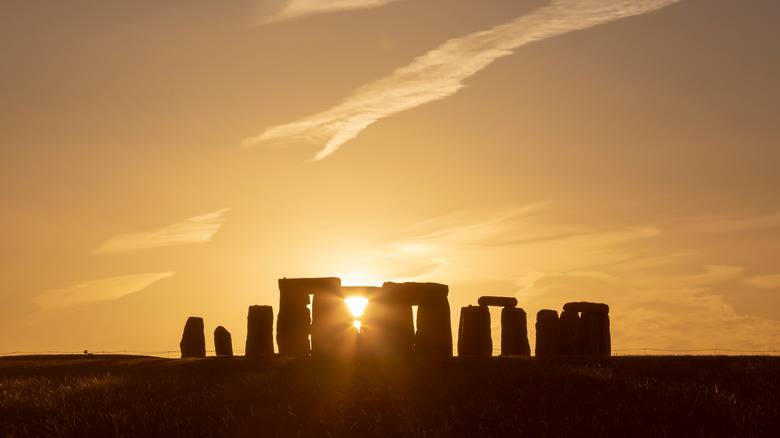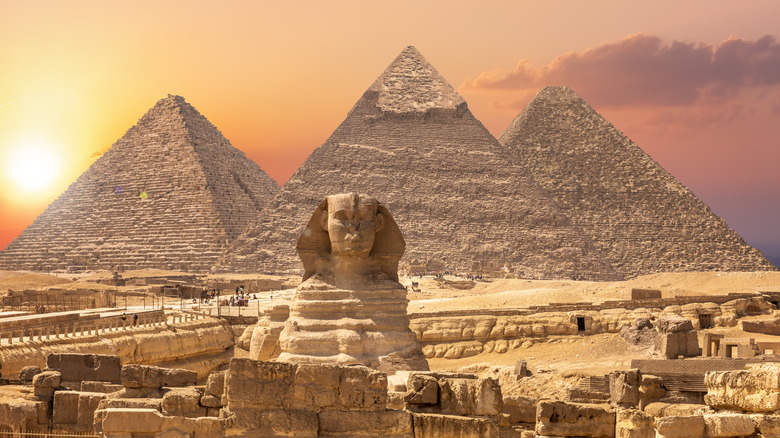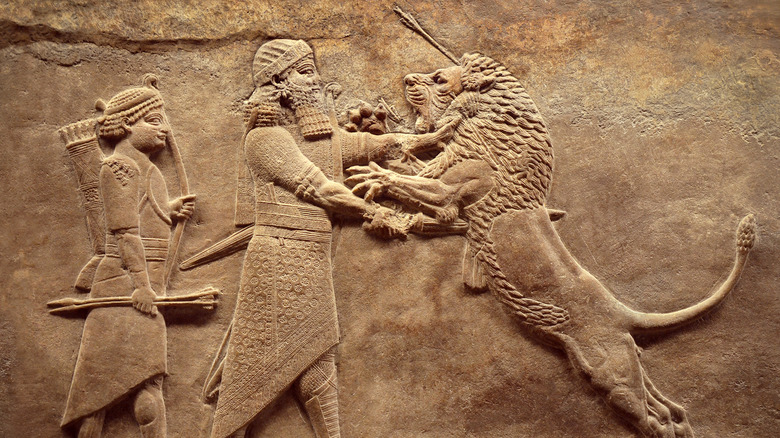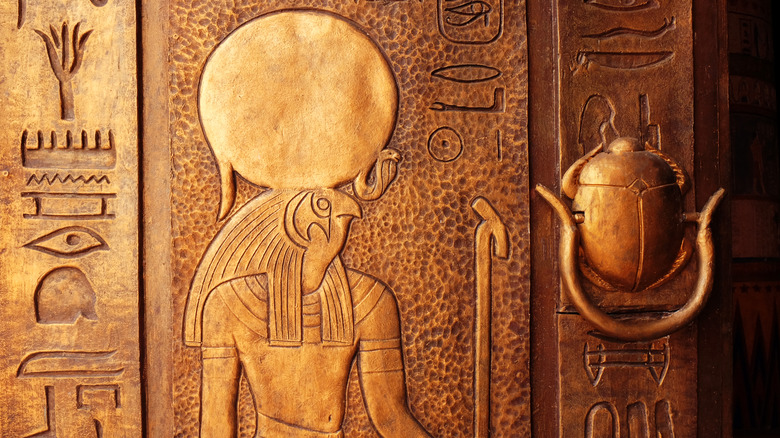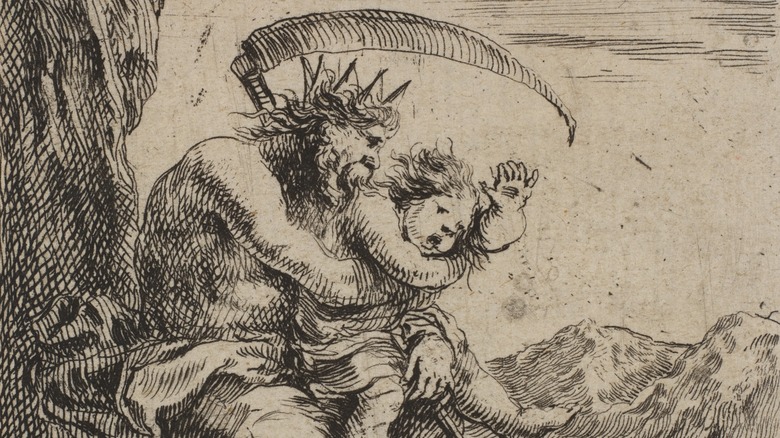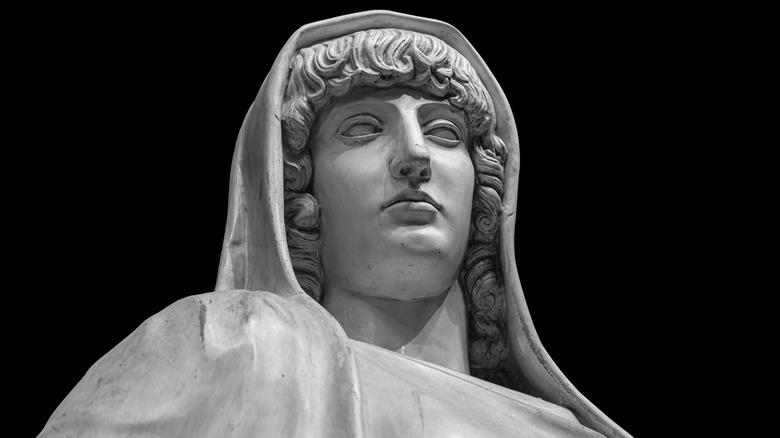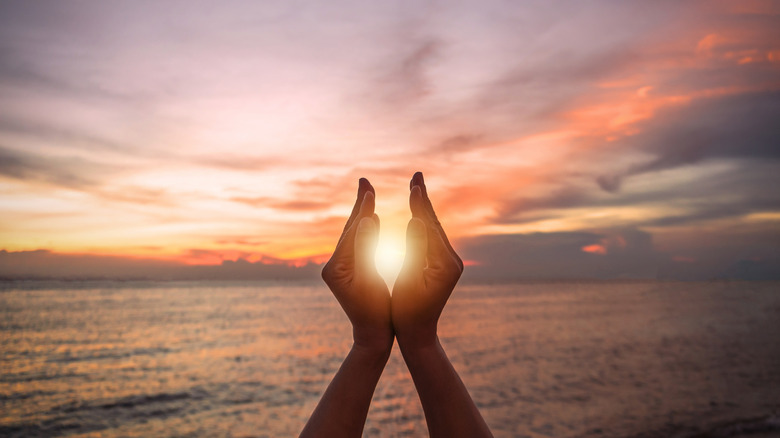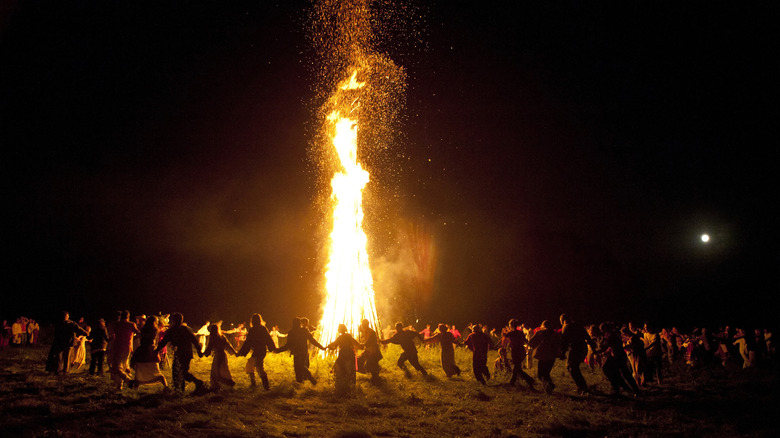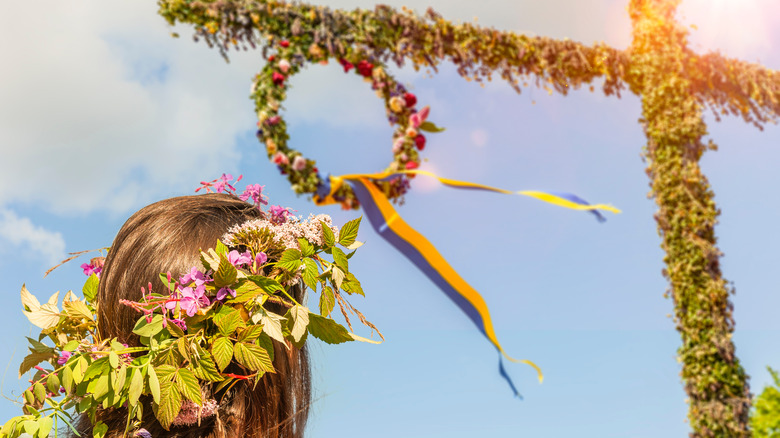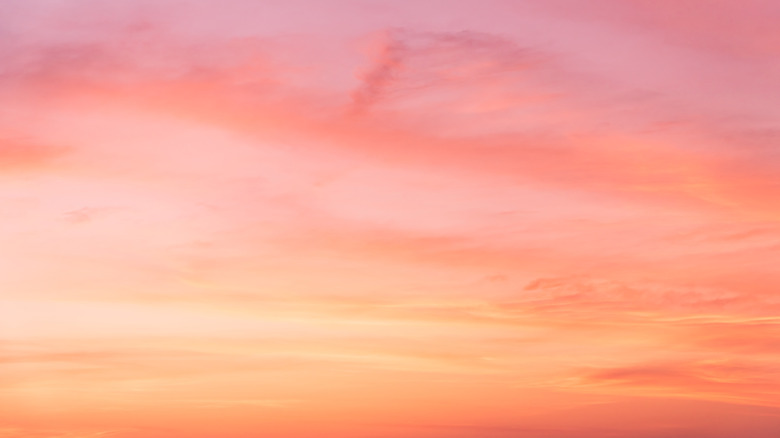The Untold Truth Of The Summer Solstice
You can feel it coming. Every day, the sun rises earlier and vanishes below the horizon later and later. Flowers and trees are dreamily swaying in warm breezes. Your winter coat is starting to feel neglected. Pretty soon, it will be the longest day of the year.
The summer solstice usually falls on June 21. While it is rarely the warmest day of the year, Earth basks in sunlight for the longest time before the days slowly start to grow shorter again. If there seems to be something enchanting about this phenomenon, the astronomical occurrence of our planet tilting closer to the sun was seen by the ancients as everything from a living fantasy to the fiery takeover of a destructive deity. There are superstitions, rituals, and traditions meant to bring happiness and ward off evil spirits.
Leave the coat behind and find out what made midsummer so mystical, mood-lifting, and almost as huge a deal as Christmas in some places. Believing in fairies is optional.
It's a literal cosmic event
Summer unofficially begins when Earth's tilt is closest to the sun in the northern hemisphere and furthest from the sun in the southern hemisphere, according to NASA.
You might not realize that you are walking on a planet that is always positioned at an angle (gravity makes sure you won't end up floating into the void). The tilt gradually changes throughout a period of six months until it ends up completely reversed when Earth reaches the halfway point on its orbit around the sun and when it completes its yearly journey. Each of these events is a solstice — which comes from the Latin words "sol" for sun and "sistere" for "standing still, according to the Franklin Institute. Now you know why Christmas is a summer holiday in Australia.
The longest day of the year is usually June 21. For those in the northern hemisphere, days grow longer and nights diminish until the longest day of the year, while in the southern hemisphere, the exact opposite happens. The maximum tilt towards the sun also explains why temperatures in the northern hemisphere rise around the summer solstice. Don't crank up the AC just yet, though. Despite being the longest day of the year, it usually doesn't boast the hottest weather. Why? As EarthSky notes, it takes a while for ice and snow to melt in some regions, which is why the desperate need for air conditioning usually hits in July.
Stonehenge probably exists because of the solstice
At least, it's one of the reasons Stonehenge was built. The often mysterious stone monument that was built during the Neolithic age was designed to be a gathering place for pagans during sacred days, and one of them was the summer solstice. The ancients deserve more credit for astronomy than they usually get, according to EarthSky. They knew how to follow the sun as the Earth traveled around it, and this is how they figured out the longest and shortest days of the year. English Heritage mentions that the prehistoric site most likely came into being for rituals having to do with the changing seasons — but no one really knows why.
Stonehenge has its main stones — which are hulking sarsens (a type of sandstone) — purposely aligned so someone standing in the center can see the sun rising right to the left of the Heel Stone, which is outside the circle, as English Heritage also observes. There might be a missing stone opposite the Heel Stone. If there were originally two megaliths, worshippers would have been transfixed by the sun rising between them.
Stonehenge is still a place of worship for modern pagans — National Geographic says thousands gather for the summer solstice.
From the right place, you can get an otherworldly view of the sun
It wasn't just Stonehenge where you could see a sunrise worthy of a photo op in the ancient world (if Instagram existed back then). The ancient Egyptians apparently knew what they were doing when they built the Sphinx, which was commissioned by Pharaoh Khafre. Stand near it during the summer solstice, and you can see the sun setting between the pyramids of Khafre and Khufu. This was all planned, if you ask archaeologist Mark Lehner, who, according to Smithsonian Magazine, found that the half-human, half-lion colossus was part of "a vast sacred machine designed to harness the power of the sun to sustain the earthly and divine order."
Other people took advantage of locations where a similar phenomenon would happen. Machu Picchu Gateway explains that the Temple of the Sun at Machu Picchu is thought to have served as a solar observatory that was purposely built for the sun to have a shining moment during the summer and winter solstice. It was also a place where the Inca would perform ritual sacrifices to appease gods. The spiral petroglyphs carved into Chaco Canyon are meant to track the sun, and the Exploratorium shows how rays will hit the center of main spiral during the summer solstice.
It was hell on earth for ancient Mesopotamians
In ancient Mesopotamia, the summer solstice was more of a funeral than a pool party. This was when Nergal (the evil alter ego of their solar deity Shamash) ruled, and he had no mercy when it came to blasting Babylon with heat and pestilence. People saw him as the embodiment of the scorching sun (via World History Encyclopedia) and feared him immensely.
The worse Nergal's temper, the hotter it would get. This hot and humid period was feared for famine (obviously) and disease. Such conditions created havens for bacteria to breed, and the USDA says that bacteria thrive in the "danger zone" between 40 and 140 degrees Fahrenheit. There were no refrigerators back then. Meaning if food began to rot, bacteria would take over. You can see where this is going. No wonder the Mesopotamians would hold funerary rituals for their god of food, Tammuz, according to Antiquity Now. Women actually cried for days on end.
Tammuz had to be dying if crops were failing and livestock were suffering in the ruthless heat. Ancient Origins recounts the myth of this deity's death at the hands of his lover Inanna, who flew into a rage when he sat on her throne while she was stuck in the underworld. She was able to resurrect him, but he could only hang around for so long before he needed to return to the realm of the dead in the summer.
Ancient Egyptians and Chinese saw solstice floods bringing fertile land
While floods can be destructive, the flooding of the Nile was something ancient Egyptians looked forward to, according to University College London. The Nile was the fount of ancient Egyptian life. There were three seasons to the Egyptian agricultural cycle, and the summer solstice fell during Akhet, the Season of the Inundation. It would usually overflow around the summer solstice.
This was also when farmers got a break from toiling in the fields, but maybe not so much of a break. Sciencing points out Akhet was when farmers were forced into labor to make sure their taxes were paid off. Whatever labor they were pushed into, such as digging canals, usually had something to do with the floods. Another thing farmers could do was use the silt washed up by the floods to ready their land for planting. Silt from the Nile was rich in minerals and the reason so many crops would thrive, according to UNC TV.
Similar flooding happened in ancient China. Monsoon season still drenches the region during the summer, but thousands of years ago, the summer solstice or Xiàzhì was also when the wheat harvest happened (per the Chinese Language Institute). Prayers and sacrifices were offered to thank Earth spirits and also in remembrance of ancestors. The solstice was so sacred that it was considered a public holiday.
For some ancients, it meant the new year
The ancient Greeks and Egyptians considered the summer solstice the beginning of the new year. Hellenion says that in Greece, the Kronia festival honored the Titan deity Kronos, also the god of the grain harvest. This was a day of reaping and ritual when the last of the wheat was gathered before the heat of summer was supposed to slowly fade. Like all ancient Greek festivals, Kronia began at sunset, according to Omphalos, which states that it was "a celebration of the Golden Age ruled by Kronos and Rhea, when there was no labor or oppression."
This festival was supposed to be overrun by chaos because when Kronos and his queen Rhea were overlords of the universe, there was no Zeus to strike order into humanity with his thunderbolt, which probably explains why it was pretty much Opposite Day. Slaves were released into the streets and allowed to breathe freedom, and they were also allowed to dine at lavish feasts with their masters.
Egyptians also celebrated the new year on the summer solstice. Antiquity Now explains that this was because the star known as Sopdet or Sothis (otherwise known as Sirius), also the brightest star, would rise in the night sky, and not to steal Isis' thunder (via Ancient Egypt Online). Sopdet was also a mother goddess and was supposed to be the wife of Sahu, which we know as Orion. The Festival of Sopdet welcomed the Egyptian New Year.
It even meant equal rights for women before that ever became a thing
Ancient Romans called the summer solstice Vestalia in honor of Vesta, the goddess of the hearth, according to Roman Republic. It was for eight days during this time that women were allowed to worship in the temple of Vesta.
The irony is that almost no women were allowed in the temple of a female goddess, and another way the temple itself was unusual in that there was no statue of Vesta herself. Where that statue would have been was a fire that was never allowed to burn out. As National Geographic says, the only females allowed inside during the rest of the year were the Vestal Virgins, six priestesses that made sure the fire was kept alive. When women were allowed inside at the temple — though not in the inner sanctum — during Vestalia, they dressed humbly and went in barefoot, with offerings of food for Vesta.
The Vestal Virgins baked special offering cakes known as mola salsa. Nova Roma translates this as "salted flour." The water used for them could only come from a spring thought to be sacred, and salt was meant for purification. These cakes were crumbled over the heads of animals that the virgins would sacrifice to Vesta first. The cakes themselves could also be thrown into a fire (though not the interminable fire) as offerings.
Halloween who? Magic is strongest when days are longest
You know how the word "solstice" comes from the sun appearing to stand still? This is what inspired the mythology that surrounds the longest day of the year, when, as historian Ronald Hutton told the National Trust UK, "the normal laws of nature or divinity could be suspended, when spirits and fairies could contact humans, when humans could exceed the usual limitations of their world."
The theme of the world turning upside down is strong in solstice folklore because the sun standing still seemed to be a supernatural phenomenon. Was this why Shakespeare's famous play about fairies frolicking and causing mayhem around this time was called "A Midsummer Night's Dream"? Shakespeare's Globe notes that when the Bard was around, there were no longer huge celebrations in larger cities, but people would have probably watched solstice rituals in the theater, so maybe.
Pagans across Europe have been lighting bonfires on the summer solstice since ancient times. There is magic in the flames since History says their ancestors thought that fire would send energy to the sun so crops would grow and provide a bountiful harvest in the fall. Young women could potentially see their future husbands through bonfires. In Scandinavia, those who leap through the flames without getting singed are thought to be married by the next solstice (via Psychology Today).
Fires blaze for the birth of a saint
While the summer solstice is a religious holiday for pagans, it is also one for Christians — this is when St. John the Baptist is thought to have been born. Some pagan traditions, such as bonfires, have been retained for the celebration otherwise known as "summer Christmas," according to Catholic Culture.
Bonfires were converted from a pagan to a Christian ritual when they were blessed for St. John by the Catholic Church, and more fire blessings exist in the liturgy if you know where to look. The feast day is June 24. While that is slightly after the summer solstice, St. John is supposed to be six months older than Jesus, which puts it at six months after Christmas. As Scientific American notes, this is another reason that it was easy to convert the pagan customs associated with the solstice to Christian traditions with the early spread of Christianity. There would even be carolers, much like Christmas.
Just like other festivals that happen on the summer solstice, St. John's Day has its own foods, many of which also have pagan ancestry. Beer and bread are common because of the grain harvest, as Catholic Culture also observes. Latvians brew their own sweet beer with barley and rye, Finns make pancakes for dinner, and Swedes eat strawberries for dessert.
This is the time to get those pesky demons out of the way
There was a darker side to bonfires. Tongues of fire were thought to ward off malevolent spirits by ancient European pagans (and still are), according to Psychology Today. Fire supposedly had the power to purify. The warmth of the sun, which stayed up longer than any other day, was also thought to send forces of darkness back to the shadows where they came from.
Wearing garlands of herbs and flowers isn't associated with the summer solstice just because everything is growing and blooms happen to be in season. There are supposed to be certain types that can work anti-demon magic, especially St. John's Wort, which used to be known as "chase devil" for a reason, as History says. Midsummer herbs were also believed to have stronger effects — from magic, of course.
Demons don't only try to mess with people in European mythology. As Bill Mak and Eric Huntington say in their book "Overlapping Cosmologies in Asia," the Iranian prophet Mani thought that the sun "on its path, encounters evil demonic forces" that caused chaos on Earth. Evil spirits in chains were locked up somewhere in the cosmos, and the sun had to counter them. The summer solstice was the afternoon of the sun when ripe fruits and vegetables would release the power of our star when eaten.
Midsummer is almost as big a deal as Christmas in Sweden
"Glad Midsommar"! That's "Happy Midsummer" in Swedish. The solstice is considered midsummer in the Land of the Midnight Sun, and in Sweden, it's a national holiday, according to Forbes. The Swedish Parliament actually made sure that Midsummer's Day falls on a weekend for this reason, as Real Scandinavia reveals. That weekend is always close to the summer solstice, and the festival ends up falling between June 20 and 26, but working hours usually end the day before. Most people take Midsummer Eve off.
Midsummer festivals where the sun never sets during the summer often involve dancing around a maypole, wearing flower crowns, and of course, a smörgåsbord. The national website of Sweden stresses just how important this holiday is over there. Anything that needs to be done before that holiday weekend is finished as fast as possible, and just about everyone ditches the city for the country, so you can expect hours of waiting in traffic.
Think about it: Winters in Sweden are rough. You would probably want to run outside and spend the whole day singing, dancing, and picking flowers, too, if you lived in a country that spends most of the year shrouded in darkness.
Longer days can affect your mood (no, really)
There is a reason you're more likely to notice mood shifts around this time of year, according to Psychology Today. More sunlight brings on a sunnier outlook. It's also easier to wake up in the morning when your bedroom is flooded with sunlight, and there is a biological reason behind that. A study published in the Journal of Clinical Endocrinology and Metabolism found that the body produces less melatonin when exposed to more light. Melatonin puts you to sleep, and when its production is suppressed by light, that makes you more awake and alert.
You might also notice you feel happier during the longest days of the year. Another study published in Environmental Health showed that higher levels of light can actually work against depression by boosting serotonin levels. Being exposed to more hours of light — especially light from the actual sun rather than artificial light — also boosts brain function since melatonin and serotonin are both involved with how you think. It can possibly also reduce the risk of stroke. Just remember to wear sunscreen so that your skin isn't wrecked from all those UV rays.
While the light of summer can lift your mood after months of the sun disappearing early, too much of the heat that comes with it can fire you up. Psychology Today warns that irritability and aggression caused by heat could be the reason so many outbursts of civil unrest have happened during the height of summer.


